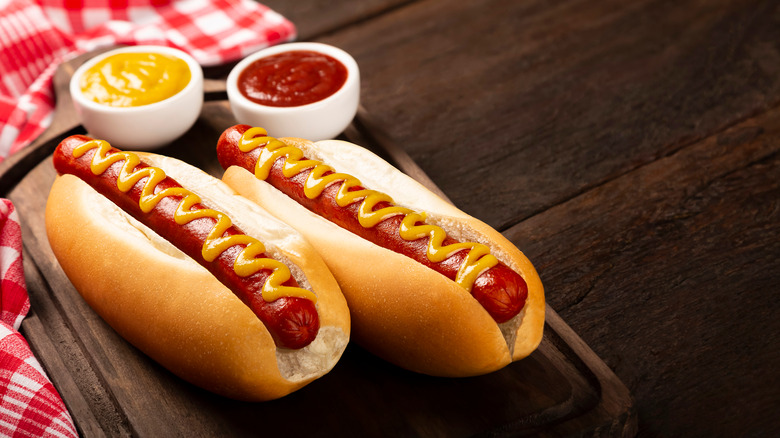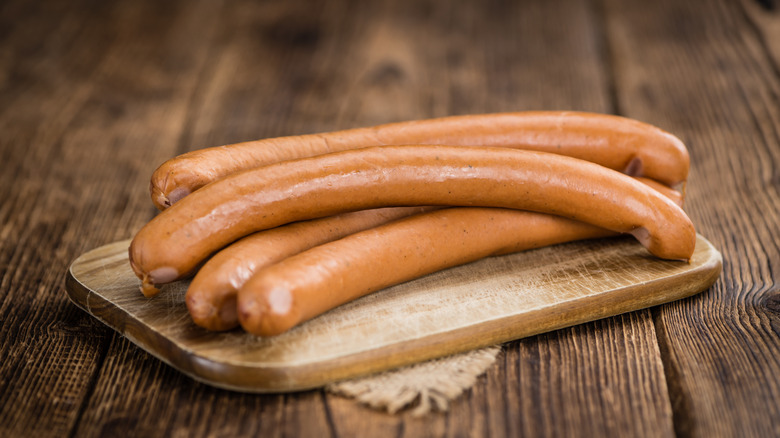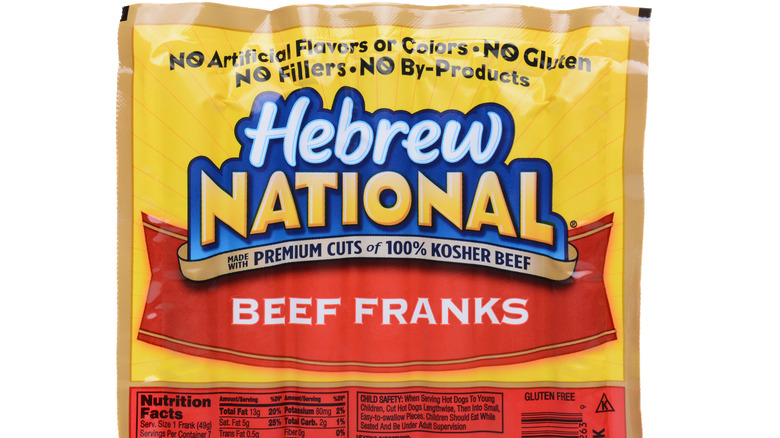False Facts About Hot Dogs Everyone Actually Believes
A staple of 4th of July cookouts and barbecues; an inextricable part of a baseball game: Hot dogs are an American classic for a reason. New Yorkers snag them from street carts with sauerkraut, onion relish, and brown mustard, while in Chicago, you'll be kicked out of the city if ever you ask for one with ketchup instead of the staple toppings of yellow mustard, onion, tomato, pickle relish, sport peppers, a kosher dill pickle, and celery salt. A Sonoran dog, native to Mexico but popular in the borderlands, is wrapped in bacon before being grilled and topped with beans, peppers, onions, cheese, mayo, salsa, and more.
There's no denying that hot dogs are an integral part of American culinary culture, but just as pervasive are the myths that surround them.
From the fact that they're made with scrap meats you'd never chat about in mixed company to the idea that a hot dog is a German specialty, from the link between hot dogs and cancer to the reason behind their unsettlingly uniform shape, we're debunking some of the most widespread myths concerning America's ballpark classic.
The original hot dog comes from Frankfurt
Given that frankfurter is a common synonym for hot dog, it's not surprising that some people assume that the hot dog does, indeed, come from the German city of Frankfurt.
The truth is a bit more complex than that.
While according to How Stuff Works, the inspiration for hot dogs likely does hail from Germany, most evidence points not to Frankfurt but to Coburg, where, in the late 17th century, a butcher by the name of Johann Georghehner invented a sausage known as the "dachshund." (Likely the source of the hot dog's canine moniker.) This sausage ostensibly arrived in Frankfurt, where it was appropriated and given a local name. Still other evidence, according to Hot-Dog.org, points to Vienna as a possible origin point for the sausages, known there as wieners or, literally, Vienna sausages.
Wherever the origins of the original sausage, until it made it to America, the hot dog lacked one essential component: the bun. Once again, several different legends proliferate, including a report that attributes their invention to a German immigrant selling them out of a pushcart in New York in the 1860s, inspiring Charles Feltman, a German baker, to open up the first Coney Island hot dog stand in 1871 and another that points, instead, to the 1893 Colombian Exposition in Chicago. Either way, experts agree: A sausage with bread may well be German, but a hot dog on a roll is resolutely American.
Hot dogs are made from the unmentionable scraps of animals
Perhaps the most pervasive hot dog-related rumor is that the beloved sausages are made from scraps no one would otherwise eat: noses, tails, feet, lips, tongues... Indeed, according to Best Food Facts, 43% of Americans are afraid to find out what exactly is in a hot dog.
But they need not fear! While hot dogs are indeed a great way to use up scraps that would otherwise be, uh, scrapped, their ingredients are nothing to turn your snout up at.
In an interview with meat scientist Janeal Yancey, Ph.D., who, in addition to her academic credentials, boasts previous experience working in a hot dog plant, Best Food Facts reveals that most of the time, hot dogs are made with "skeletal meat," aka trimmings from the same roasts, chops, and other cuts you're used to cooking at home. The rumor, Yancey says, that hot dogs are made up of leftovers "isn't really true."
"The trimmings used to make hot dogs are pieces of the meat that don't make good steaks and roasts because they aren't a certain tenderness, size, shape, or weight," she says. But these scraps aren't anything you should fear.
Hot dogs are raw when you buy them
On cooking shows, on-screen chefs handle raw meat with incredible care, washing their hands and sanitizing their boards after any contact with the uncooked product. These are habits we should all adopt at home... but with hot dogs, you can rest easy. While a package of hot dogs may resemble raw sausages, hot dogs stand out from other links in that they're sold fully cooked.
Indeed, as Business Insider explains, hot dogs are cooked not just once but twice before they reach your meat aisle. First, the meat is pre-cooked to kill the "fair amount" of bacteria that are left behind during the butchering process, according to the outlet; this step also separates the remaining meat, fat, and bones, making it easier to manage the trimmings and turn them into the hot dogs you know and love.
After this pre-cooking step, according to the outlet, the "meat emulsion" that makes up a hot dog is piped into casings and fully cooked a second time, by being smoked in a smokehouse. The resulting hot dog links, according to meat scientist Janeal Yancey, PhD, are therefore actually edible straight out of the package.
"That's what's great about a hot dog — it's a safe, ready-to-eat product," she tells Best Food Facts. "You can cook it again – you can grill it, microwave it, boil it, etc., but you don't have to."
Hot dogs don't contain sugar
These days, most Americans are eating way too much sugar. In fact, according to Healthy Food America, a whopping 58% of Americans exceed the recommended daily limit for added sugar, which the Dietary Guidelines set for Americans at less than 10% of total calories. But this doesn't necessarily mean Americans are hooked on sweets.
Sugar is hiding in plain sight in a whopping 74% of packaged foods, according to a study from the Academy of Nutrition and Dietetics, including things like yogurt, pasta sauce, canned soup, and, you guessed it, hot dogs.
According to Coleman Natural, which produces high-end hot dogs, seasonings including paprika, garlic, onion, mustard, coriander, and mace are usually added to hot dogs, in addition to sweeteners. Coleman Natural relies on cane sugar and honey to give its hot dog mixture that standard slight sweetness, but other brands use instead high-fructose corn syrup, the over-consumption of which has been linked to hypertension and metabolic syndrome.
Most hot dogs are pork-based
It would be easy to assume that hot dogs, like most sausages, are pork-based, but this isn't necessarily the case. While some hot dogs are indeed made with pork, including those from stalwart favorite Oscar Mayer, those on either end of the quality spectrum — be it low or high — are not.
Inexpensive hot dogs, meat scientist Janeal Yancey, Ph.D. tells Best Food Facts, are often made from something called "mechanically separated chicken," made, as its name suggests, by mechanically pulling the chicken from the bone. "It's not an unsafe or unwholesome product," she tells the outlet. "It's just a cheaper protein source."
The highest-quality hot dogs, meanwhile, are often made with beef. This stems in part from the influence of Polish Jewish immigrant Nathan Handwerker, who, in the 1910s, made his living working at a Coney Island hot dog stand. He later launched the now-beloved Nathan's kosher frank, and since pork isn't kosher, his dogs are made exclusively with beef. Today, high-end brands like Snake River Farms pride themselves on using exclusively American Wagyu beef for a top-quality dog.
These days, even mid-range hot dogs tend to use a mix of both. The Spruce Eats notes that while hot dogs made either with exclusively beef or exclusively pork will say so on the package, when the word "meat" is used, it usually refers to a mix of pork and beef — usually 40% of the former and 60% of the latter.
Hot dogs are sold in casing like sausages
Given their shape — and the fact that they are, technically, a member of the sausage family — it's easy to assume that hot dogs have casings. But think about that snap you get when you bite into a perfect hot dog — not exactly the same as what you get with a brat, is it?
That's because hot dogs, while cooked in casings, are actually stripped of this outside layer before being packaged and sold. As Hot-Dog.org details, hot dogs begin with a batter or emulsion of meat and seasonings, which is pumped into a "stuffer": a machine that pipes the mixture into permeable cellulose casings. These casings are specially designed to contain the batter, all the while allowing it to absorb the flavor of the smoke used to cook them. Once the hot dogs are fully cooked (and therefore solid), they are cooled with water and, finally, stripped of the casing, of which they retain the shape once cooked.
Need more evidence? You need look no further than the wrinkly bit at the end of every link. This, meat scientist Janeal Yancey, Ph.D. tells Best Food Facts, comes from where the casing was twisted to separate each dog from its neighbor.
Hot dogs cause cancer
Rumors of hot dogs' health hazards are not entirely unfounded. They are, after all, indeed a member of the category of processed meats (alongside ham, bacon, and salami) that have been classified by the World Health Organization as a Group 1 carcinogen. This classification means that there is strong evidence in favor of their link with certain cancers, such as bowel and stomach cancer.
And this risk is only increased when hot dogs are prepared, in time-honored tradition, over the grill. One 2010 research review from Vanderbilt University posited a link between the development of certain cancers and exposure to heterocyclic amines, a class of chemical that develops when red meat is cooked, particularly well-done or char-grilled, according to TIME. But evidence of this alleged link, according to the outlet, is "inconsistent," and Dr. Stephen Freedland, director of the Center for Integrated Research in Cancer and Lifestyle at Cedars-Sinai Medical Center in Los Angeles, tells TIME that you would have to eat char-grilled meat two or three times a week before the increased cancer risk became worrisome.
For Fatherly, while hot dogs are certainly not a health food, the "real danger" isn't their possible carcinogenic nature, but simply the fact that they're quite high in fat and sodium. As an everyday indulgence? Not great. But as a sometimes food? Totally fine.
Pregnant women can't eat hot dogs
When a woman becomes pregnant, her diet understandably changes quite a bit, for the safety of the growing fetus. That means no alcohol, no raw milk soft cheese, no sushi, and no hot dogs. Or does it?
While pregnant women are indeed encouraged to steer clear of deli meats due to the risk of listeria contamination, according to VeryWell Family, thankfully, when a craving hits, there is a loophole! If you cook your deli meats, Willow Jarosh, MS, RD, a registered dietitian-nutritionist and author of "Healthy, Happy Pregnancy Cookbook," tells the outlet, they're totally safe to enjoy. "It should really be cooked to steaming hot, which is about 165 degrees," she adds.
But as long as you stick to this rule, you're in the clear to enjoy your hot dogs not just grilled or boiled but also cooked into a hot dog casserole or mummified in pastry.
Hot dogs have always had a working class reputation
Given their inexpensive price tag and protein-rich nature, hot dogs have long been a popular choice for those looking for a cheap, filling meal. Indeed, when Nathan Handwerker launched his Coney Island hot dog stand in 1915, he was selling what would become the now-famous Nathan's kosher franks for just five cents (as opposed to the 10 charged by his former boss and instigator of Coney Island dogs, Charles Feltman, according to What's Cooking America?).
Thanks to their low price point, hot dogs gained immensely in popularity during the Great Depression, when, Serious Eats reports, vegetable stands started selling "depression sandwiches" — basically a hot dog topped with veggie scraps.
But just because they were inexpensive didn't mean hot dogs couldn't dress to impress. To wit, when President Franklin Roosevelt hosted King George VI at a Hyde Park picnic in 1939, first lady Eleanor served the royal couple grilled hot dogs, much to the king's delight. According to History.com, he even asked for seconds!









